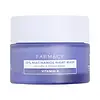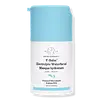What's inside
What's inside
 Key Ingredients
Key Ingredients

 Benefits
Benefits

 Concerns
Concerns

 Ingredients Side-by-side
Ingredients Side-by-side

Water
Skin ConditioningPropanediol
SolventNiacinamide
SmoothingC15-19 Alkane
SolventCaprylic/Capric Triglyceride
MaskingGlycerin
HumectantPanthenol
Skin Conditioning1,2-Hexanediol
Skin ConditioningCetearyl Olivate
Cetearyl Alcohol
EmollientSorbitan Olivate
EmulsifyingButyrospermum Parkii Butter
Skin ConditioningBetaine
HumectantVaccinium Corymbosum Seed Oil
AntioxidantTocopheryl Acetate
AntioxidantBeta-Glucan
Skin ConditioningBisabolol
MaskingAllantoin
Skin ConditioningMelia Azadirachta Flower Extract
Skin ConditioningGlycogen
HumectantCoccinia Indica Fruit Extract
Skin ConditioningLactobacillus Ferment
Skin ConditioningCorallina Officinalis Extract
Skin ConditioningSolanum Melongena Fruit Extract
Skin ConditioningAloe Barbadensis Flower Extract
EmollientSimmondsia Chinensis Seed Oil
EmollientZingiber Officinale Root Extract
MaskingCurcuma Longa Root Extract
MaskingOcimum Basilicum Flower/Leaf Extract
TonicOcimum Sanctum Leaf Extract
Skin ConditioningMaltodextrin
AbsorbentArginine
MaskingCarbomer
Emulsion StabilisingPentylene Glycol
Skin ConditioningSodium Phytate
Melia Azadirachta Leaf Extract
Skin ConditioningCaprylyl Glycol
EmollientWater, Propanediol, Niacinamide, C15-19 Alkane, Caprylic/Capric Triglyceride, Glycerin, Panthenol, 1,2-Hexanediol, Cetearyl Olivate, Cetearyl Alcohol, Sorbitan Olivate, Butyrospermum Parkii Butter, Betaine, Vaccinium Corymbosum Seed Oil, Tocopheryl Acetate, Beta-Glucan, Bisabolol, Allantoin, Melia Azadirachta Flower Extract, Glycogen, Coccinia Indica Fruit Extract, Lactobacillus Ferment, Corallina Officinalis Extract, Solanum Melongena Fruit Extract, Aloe Barbadensis Flower Extract, Simmondsia Chinensis Seed Oil, Zingiber Officinale Root Extract, Curcuma Longa Root Extract, Ocimum Basilicum Flower/Leaf Extract, Ocimum Sanctum Leaf Extract, Maltodextrin, Arginine, Carbomer, Pentylene Glycol, Sodium Phytate, Melia Azadirachta Leaf Extract, Caprylyl Glycol
Water
Skin ConditioningSqualane
EmollientPropanediol
SolventNiacinamide
SmoothingOlive Oil Glycereth-8 Esters
EmollientCoconut Alkanes
EmollientCocos Nucifera Water
MaskingSimmondsia Chinensis Seed Oil
EmollientAmmonium Acryloyldimethyltaurate/Vp Copolymer
Glycerin
HumectantMannitol
HumectantSclerocarya Birrea Seed Oil
HumectantSclerocarya Birrea Seed Butter
EmollientSodium PCA
HumectantOpuntia Tuna Fruit Extract
Skin ConditioningLinum Usitatissimum Seed Oil
PerfumingSorbitol
HumectantQuercetin
AntioxidantTrehalose
HumectantZea Mays Oil
EmulsifyingCetyl Alcohol
EmollientSucrose
HumectantCreatine
Skin ConditioningInositol
HumectantPentylene Glycol
Skin ConditioningFerulic Acid
AntimicrobialHydroxytyrosol
BleachingBehenic Acid
CleansingLinoleic Acid
CleansingCholesterol
EmollientCeramide Ns
Skin ConditioningCeramide AP
Skin ConditioningCeramide Eos
Skin ConditioningCeramide NP
Skin ConditioningCeramide EOP
Skin ConditioningPhospholipids
Skin ConditioningSodium Hyaluronate Crosspolymer
HumectantMagnesium PCA
HumectantMicrocrystalline Cellulose
AbsorbentAdenosine
Skin ConditioningSodium Hyaluronate
HumectantXanthan Gum
EmulsifyingCaprooyl Phytosphingosine
Skin ConditioningAscorbyl Palmitate
AntioxidantHydroxypropyl Methylcellulose
Emulsion StabilisingCaprooyl Sphingosine
Skin ConditioningCoco-Caprylate/Caprate
EmollientCeteareth-25
CleansingCitric Acid
BufferingGlyceryl Caprylate
EmollientPhenoxyethanol
PreservativeCaprylyl Glycol
EmollientSodium Benzoate
MaskingTocopherol
AntioxidantChlorphenesin
AntimicrobialPotassium Sorbate
PreservativeEthylhexylglycerin
Skin ConditioningWater, Squalane, Propanediol, Niacinamide, Olive Oil Glycereth-8 Esters, Coconut Alkanes, Cocos Nucifera Water, Simmondsia Chinensis Seed Oil, Ammonium Acryloyldimethyltaurate/Vp Copolymer, Glycerin, Mannitol, Sclerocarya Birrea Seed Oil, Sclerocarya Birrea Seed Butter, Sodium PCA, Opuntia Tuna Fruit Extract, Linum Usitatissimum Seed Oil, Sorbitol, Quercetin, Trehalose, Zea Mays Oil, Cetyl Alcohol, Sucrose, Creatine, Inositol, Pentylene Glycol, Ferulic Acid, Hydroxytyrosol, Behenic Acid, Linoleic Acid, Cholesterol, Ceramide Ns, Ceramide AP, Ceramide Eos, Ceramide NP, Ceramide EOP, Phospholipids, Sodium Hyaluronate Crosspolymer, Magnesium PCA, Microcrystalline Cellulose, Adenosine, Sodium Hyaluronate, Xanthan Gum, Caprooyl Phytosphingosine, Ascorbyl Palmitate, Hydroxypropyl Methylcellulose, Caprooyl Sphingosine, Coco-Caprylate/Caprate, Ceteareth-25, Citric Acid, Glyceryl Caprylate, Phenoxyethanol, Caprylyl Glycol, Sodium Benzoate, Tocopherol, Chlorphenesin, Potassium Sorbate, Ethylhexylglycerin
 Reviews
Reviews

Ingredients Explained
These ingredients are found in both products.
Ingredients higher up in an ingredient list are typically present in a larger amount.
Caprylyl Glycol is a humectant and emollient, meaning it attracts and preserves moisture.
It is a common ingredient in many products, especially those designed to hydrate skin. The primary benefits are retaining moisture, skin softening, and promoting a healthy skin barrier.
Though Caprylyl Glycol is an alcohol derived from fatty acids, it is not the kind that can dry out skin.
This ingredient is also used as a preservative to extend the life of products. It has slight antimicrobial properties.
Learn more about Caprylyl GlycolGlycerin is already naturally found in your skin. It helps moisturize and protect your skin.
A study from 2016 found glycerin to be more effective as a humectant than AHAs and hyaluronic acid.
As a humectant, it helps the skin stay hydrated by pulling moisture to your skin. The low molecular weight of glycerin allows it to pull moisture into the deeper layers of your skin.
Hydrated skin improves your skin barrier; Your skin barrier helps protect against irritants and bacteria.
Glycerin has also been found to have antimicrobial and antiviral properties. Due to these properties, glycerin is often used in wound and burn treatments.
In cosmetics, glycerin is usually derived from plants such as soybean or palm. However, it can also be sourced from animals, such as tallow or animal fat.
This ingredient is organic, colorless, odorless, and non-toxic.
Glycerin is the name for this ingredient in American English. British English uses Glycerol/Glycerine.
Learn more about GlycerinNiacinamide is a multitasking form of vitamin B3 that strengthens the skin barrier, reduces pores and dark spots, regulates oil, and improves signs of aging.
And the best part? It's gentle and well-tolerated by most skin types, including sensitive and reactive skin.
You might have heard of "niacin flush", or the reddening of skin that causes itchiness. Niacinamide has not been found to cause this.
In very rare cases, some individuals may not be able to tolerate niacinamide at all or experience an allergic reaction to it.
If you are experiencing flaking, irritation, and dryness with this ingredient, be sure to double check all your products as this ingredient can be found in all categories of skincare.
When incorporating niacinamide into your routine, look out for concentration amounts. Typically, 5% niacinamide provides benefits such as fading dark spots. However, if you have sensitive skin, it is better to begin with a smaller concentration.
When you apply niacinamide to your skin, your body converts it into nicotinamide adenine dinucleotide (NAD). NAD is an essential coenzyme that is already found in your cells as "fuel" and powers countless biological processes.
In your skin, NAD helps repair cell damage, produce new healthy cells, support collagen production, strengthen the skin barrier, and fight environmental stressors (like UV and pollution).
Our natural NAD levels start to decline with age, leading to slower skin repair, visible aging, and a weaker skin barrier. By providing your skin niacinamide, you're recharging your skin's NAD levels. This leads to stronger, healthier, and younger looking skin.
Another name for vitamin B3 is nicotinamide. This vitamin is water-soluble and our bodies don't store it. We obtain Vitamin B3 from either food or skincare. Meat, fish, wheat, yeast, and leafy greens contain vitamin B3.
The type of niacinamide used in skincare is synthetically created.
Learn more about NiacinamidePentylene glycol is typically used within a product to thicken it. It also adds a smooth, soft, and moisturizing feel to the product. It is naturally found in plants such as sugar beets.
The hydrophilic trait of Pentylene Glycol makes it a humectant. As a humectant, Pentylene Glycol helps draw moisture from the air to your skin. This can help keep your skin hydrated.
This property also makes Pentylene Glycol a great texture enhancer. It can also help thicken or stabilize a product.
Pentylene Glycol also acts as a mild preservative and helps to keep a product microbe-free.
Some people may experience mild eye and skin irritation from Pentylene Glycol. We always recommend speaking with a professional about using this ingredient in your routine.
Pentylene Glycol has a low molecular weight and is part of the 1,2-glycol family.
Learn more about Pentylene GlycolPropanediol is an all-star ingredient. It softens, hydrates, and smooths the skin.
It’s often used to:
Propanediol is not likely to cause sensitivity and considered safe to use. It is derived from corn or petroleum with a clear color and no scent.
Learn more about PropanediolThis oil comes from the seeds of the desert shrub called Jojoba. It is more commonly known as jojoba oil, a non-comedogenic oil.
Jojoba oil does not contain fragrance and has many fatty-acids, making it a great soothing ingredient.
It also contains Vitamin E, a great moisturizing ingredient. Vitamin E is also an antioxidant and protects your skin against oxidative damage.
This ingredient humectant properties, meaning it helps draw moisture from the air. This helps keep your skin hydrated.
While jojoba has antibacterial properties, it is only able to kill some strains of bacteria.
Studies also show it helps in wound healing. In fact, Indigenous cultures have used jojoba as a moisturizer and to help treat burns for centuries.
Fun fact: Jojoba oil similar to natural human skin sebum, so it has a great effect on dry skin. It is also promising with helping to regulate sebum production.
Due to its fatty acid content, Jojoba oil may not be fungal acne safe. We recommend speaking with a professional if you have any concerns.
Learn more about Simmondsia Chinensis Seed OilWater. It's the most common cosmetic ingredient of all. You'll usually see it at the top of ingredient lists, meaning that it makes up the largest part of the product.
So why is it so popular? Water most often acts as a solvent - this means that it helps dissolve other ingredients into the formulation.
You'll also recognize water as that liquid we all need to stay alive. If you see this, drink a glass of water. Stay hydrated!
Learn more about Water